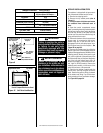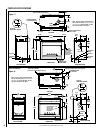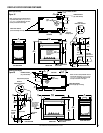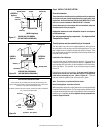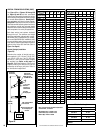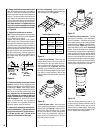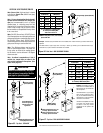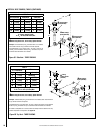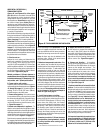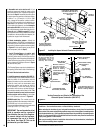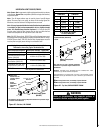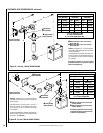
17
NOTE: DIAGRAMS & ILLUSTRATIONS ARE NOT TO SCALE.
First Vent
Component
Align the dimple (four places)
with the opening of the locking
incline channel on appliance
collar. Twist vent component
clockwise to engage and seal.
Locking
Incline Channel
Dimple
Appliance collar
Vent / Appliance Collar
Connection
Align the dimple (four places) of the
upper vent section with the opening of
the locking incline channel on the
lower vent section. Twist vent
component clockwise to engage and
seal until arrow and dimple align.
Locking
Incline Channel
Dimple
Arrow
Connected
Vent Sections
Vent / Vent Section
Connection
Arrow
Arrow
Figure 26
Figure 27
Figure 29
Figure 28
C. Attach vent components to each other
- Other vent sections may be added to the
previously installed section in accordance with
the requirements of the vertical vent figures
and tables. To add another vent component
to a length of vent run, align the dimpled end
over the inclined channel end of the previously
installed section, adjusting the radial alignment
until the four locking dimples are aligned with
the inlets of the four incline channels of the
previous section.
Push the vent component against the previous
section until it fully engages, then twist the
component clockwise running the dimples down
and along the incline channels until they seat at
the end of the channels.This seating position
is indicated by the alignment of the arrow and
dimple as shown in Figure 28.
D. Install firestop/spacer at ceiling (Figure
29 ) - When using Secure Vent, use SV4.5VF
firestop/spacer at ceiling joists; when using
Secure Flex, use SF4.5VF firestop/spacer. If
there is living space above the ceiling level,
the firestop/spacer must be installed on the
bottom side of the ceiling. If attic space is
above the ceiling, the firestop/spacer must
be installed on the top side of the joist. Route
the vent sections through the framed opening
and secure the firestop/spacer with 8d nails
or other appropriate fasteners at each corner.
Remember to maintain 1" (25 mm) clearance
to combustibles, framing members, and attic
or ceiling insulation when running vertical
chimney sections. Attic insulation shield
(96K94) may be used to obtain the required
clearances indicated here. See installation
accessories tables on pages 38 and 39.
Vertical (Offset) Installation
Analyze the vent routing and determine the
quantities of vent sections and number of
elbows required. Refer to Vertical Vent Figures
and Tables on page 16 to select the type of
vertical installation desired. Vent sections are
available in net lengths of 4-1/2" (114 mm),
10-1/2" (267 mm), 22-1/2" (572 mm), 34-1/2"
(876 mm) and 46-1/2" (1181 mm). Refer to the
Effective Vent Length Chart Table 7 on page
16 for an aid in selecting length combinations.
Elbows are available in 90° and 45° configura-
tions. Refer to Figure 30 for the SV4.5E45 and
SV4.5E90 elbow dimensional specifications.
Where required, a telescopic vent section
(SV4.5LA) may be used to provide the installer
with an option in installing in tight and confined
spaces or where the vent run made up of fixed
length pieces develops a joint in a undesirable
location, or will not build up to the required
length. The SV4.5LA Telescopic Vent Section
has an effective length of from 1-1/2" (38 mm)
to 7-1/2" (191 mm). The SV4.5LA is fitted with
a locking inclined channel end (identical to a
normal vent section component) and a plain end
with 3 pilot holes. Slip the plain end over the
locking channel end of a standard SV4.5 vent
component the required distance and secure
with three screws.
Maintain a minimum 1" (25 mm) clearance to
combustible materials for all vertical elements.
Clearances for all horizontal elements are 3"
(76 mm) on top, 1" (25 mm) on sides and 1"
(25 mm) on the bottom.
A. Frame ceiling opening - Use a plumb line
from the ceiling above the appliance to locate
center of the vertical run. Cut and/or frame an
opening, 10-1/2" x 10-1/2" (267mm x 267mm)
inside dimensions, about this center mark
(Figure 26 ).
To attach a vent component to the appliance
collar, align the dimpled end over the collar,
adjusting the radial alignment until the four
locking dimples are aligned with the inlet of
the four inclined channels on the collar (refer to
Figure 27 ). Push the vent component against
the collar until it fully engages, then twist the
component clockwise, running the dimples
down and along the incline channels until they
seat at the end of the channels. The unitized
design of the Secure Vent components will
engage and seal both the inner and outer pipe
without the need for sealant or screws. If desired
a #6 x 1/2" screw may be used at the joint, but
it is not required as the pipe will securely lock
when twisted.
Note: An elbow may also be attached to the
appliance collar. Attach in the same manner
as you would a vent section.
B. Attach vent components to appliance -
Secure Vent SV4.5 direct vent system compo-
nents are unitized concentric pipe components
featuring positive twist lock connections (see
Figures 27 and 28 ).
All of the appliances covered in this document
are fitted with collars having locking inclined
channels. The dimpled end of the vent com-
ponents fit over the appliance collar to create
the positive twist lock connection.
1” (25.4 mm)
Minimum
Clearance to
Combustibles
8 ft. (2.4 M)
Maximum
v SV4.5VF
Firestop / spacer
uSV4.5SP
Support Plate
uSV4.5SU
Support Strap
Shown With
Optional
Radiant
Panels
uSecured
to Vent with
Appropriate
Fasteners
Ceiling
Framing
vWhen
using
secure
Flex, use
Firestop/
Spacer
SF4.5VF
SV4.5FA or
SV4.5FB Flashing
and SV4.5SC
Storm Collar
SV4.5CGV-1
Termination
10-1/2" Min.
(267 mm)
10-1/2" Min.
(267 mm)



